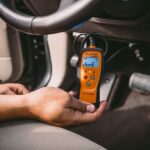It’s a common scenario: you’re ready to diagnose your 2000 Subaru Forester using an OBD2 scanner, but to your surprise, there’s no power at the OBD2 connector. This can be frustrating, preventing you from reading trouble codes and understanding your car’s health. Let’s delve into why this might be happening and how to address it, focusing on maintaining your Subaru’s computer memory during battery changes.
When you disconnect your car battery, you’re not just losing the power to start the engine. Modern vehicles, including the 2000 Subaru Forester, rely on constant power to maintain the settings and learned data in various control modules. This includes everything from your radio presets and clock to crucial engine management parameters that optimize your car’s performance. Think of it like your computer losing its memory when you unplug it without saving your work.
Ideally, when replacing a car battery, you want to maintain power to these systems to prevent data loss. In some vehicles, the accessory power outlet remains live even when the ignition is off, allowing you to connect a 12V power source to preserve these settings. However, Subaru Foresters from the year 2000, unfortunately, do not have this feature. Their accessory outlets are not constantly powered. This means you need to find an alternative power source to keep your systems alive during a battery change.
One often-suggested workaround is using the OBD2 connector, specifically pin 16. This pin is designed to be constantly powered, providing a potential point to introduce an external 12V source. Many automotive service centers utilize adapters that connect a portable jump starter or battery maintainer to the OBD2 port via pin 16, often incorporating a 7.5 Amp fuse for safety.
Alt text: A detailed diagram of an OBD2 connector pinout, highlighting pin 16 which is used for battery positive voltage.
This method can work effectively, but it’s crucial to ensure that no electrical accessories are switched on in the car during this process. The modules requiring power draw a minimal current, well within the 7.5 Amp fuse rating. However, if you inadvertently open a door, activating interior lights, or switch on the headlights, the increased current draw could easily exceed 7.5 Amps. If this happens while the car battery is disconnected, the fuse will blow, acting as a safety measure.
If the fuse blows, the result is the same as if you had simply disconnected the battery without any power maintenance – you’ll lose your radio presets, clock settings, and potentially experience a slightly rough idle until the engine control module (ECM) relearns its optimal parameters. This “relearning” process is usually quick, but it can be momentarily noticeable.
It’s possible that if you’re experiencing no power at your OBD2 connector, a blown fuse in this circuit could be the culprit. While this fuse issue itself won’t trigger a check engine light (CEL), it will certainly prevent a code reader that relies on the car’s power from functioning. Therefore, if your OBD2 scanner is unresponsive on your 2000 Subaru Forester, checking the fuse associated with the OBD2 port or the constant power supply is a vital first step in your troubleshooting process. Consult your owner’s manual or a repair manual to locate the correct fuse and inspect it for any signs of damage. Replacing a blown fuse might be the simple solution to restore power to your OBD2 connector and get your diagnostic efforts back on track.
